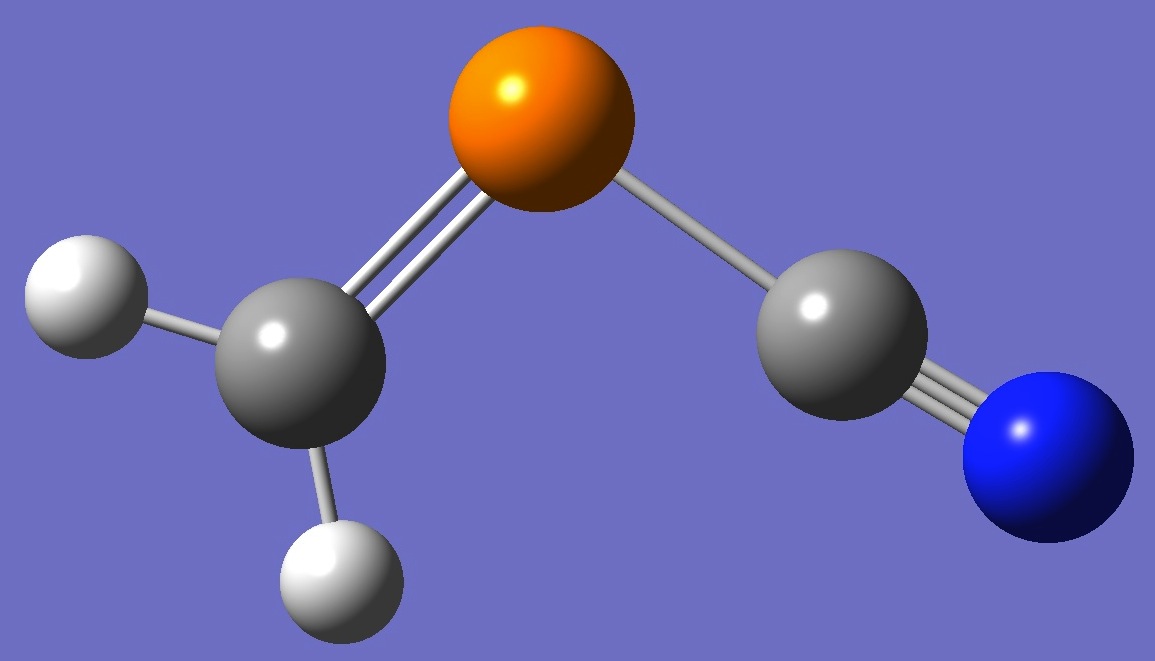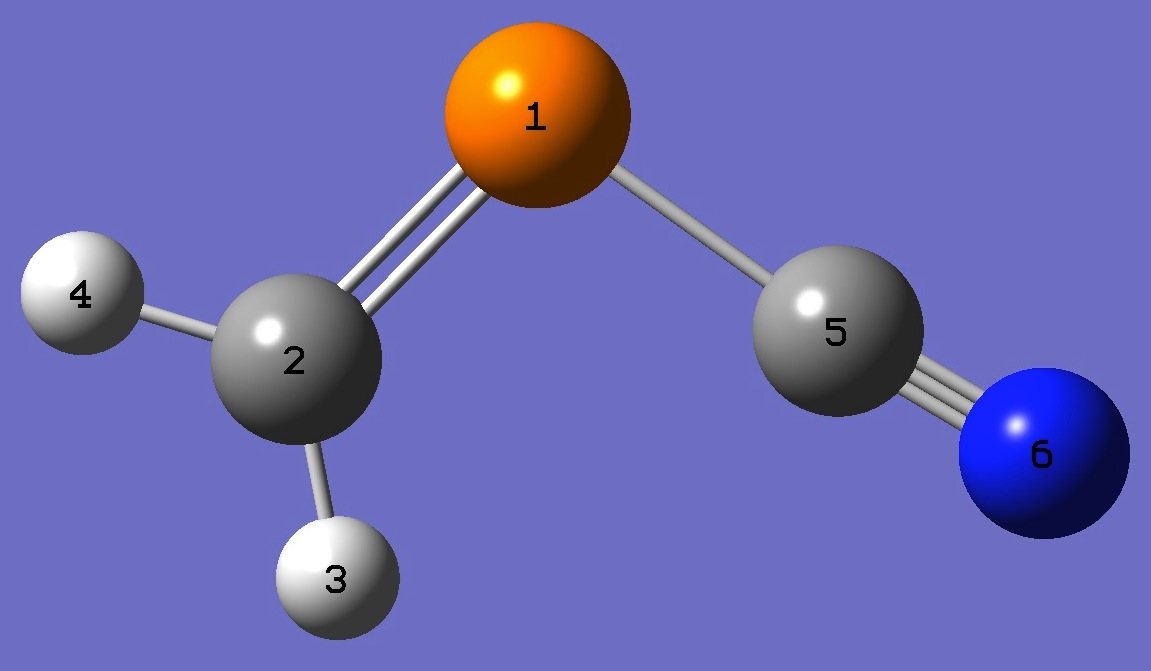|
|
|
|
|
|
|
|
|
|
|
|
|
|
|
|
|
|
|
|
|
H2C=P-CN
|

|
|
|
|
|
|
|
|
|
|
|
|
|
|
|
|
|
|
|
|
|
|
|
|
|
|
|
|
|
|
|
|
|
|
Nitrogen
|
|
|
Nuclear
Quadrupole Coupling Constants |
|
|
|
in P-Cyanophosphaethene |
|
|
|
|
|
|
|
|
|
|
|
|
|
|
|
|
|
|
|
|
|
|
|
|
|
|
|
|
|
|
|
|
|
Calculation of the nitrogen nqcc
tensor in P-cyanophosphaethene was made here on molecular structures given by MP2/6-311+G(3df,3pd) and MP2/aug-cc-pVTZ
optimization, each corrected with approximate equilibrium CN bond length. These nqcc's are given in Table 1. Structure parameters are given
in Z-matrix format in Table 2, rotational constants in Table 3,
dipole moments and quartic centrifugal distortion constants in Table 4.
|
|
|
|
|
|
|
|
|
|
|
|
|
In Table 1, subscripts a,b,c refer to
the principal axes of the inertia tensor, subscripts x,y,z to the
principal axes of the nqcc tensor. ETA = (Xxx - Xyy)/Xzz. Ø (degrees) is the angle between
its subscripted parameters.
|
|
|
RSD is the residual standard
deviation
of calibration of the B3PW91/6-311+G(df,pd) model for calculation of
the efg's/nqcc's. |
|
|
|
|
|
|
|
|
|
|
|
|
|
|
|
|
|
|
|
|
|
|
| |
|
|
|
|
|
|
|
|
|
Table 1.
Nitrogen nqcc's in H2C=P-CN
(MHz). Calculation was made here on molecular structures given by (1) MP2/6-311+G(3df,3pd) and (2) MP2/aug-cc-pVTZ
optimization, each with approximate re(CN).
|
|
| |
|
|
|
|
|
|
|
|
|
|
|
Calc (1)
|
|
Calc (2)
|
|
Expt
|
|
| |
|
|
|
|
|
|
|
|
|
Xaa |
-
|
4.274
|
-
|
4.248
|
|
|
|
|
Xbb |
|
1.743
|
|
1.734
|
|
|
|
|
Xcc |
|
2.531
|
|
2.514
|
|
|
|
|
Xab |
|
1.690
|
|
1.709
|
|
|
|
|
|
|
|
|
|
|
|
|
|
RSD |
|
0.030 (1.3 %) |
|
0.030 (1.3 %) |
|
|
|
|
|
|
|
|
|
|
|
|
|
Xxx |
|
2.185
|
|
2.188
|
|
|
|
|
Xyy |
|
2.531
|
|
2.514
|
|
|
|
|
Xzz |
-
|
4.716
|
-
|
4.702
|
|
|
|
|
ETA |
|
0.073
|
|
0.069
|
|
|
|
|
Øz,a |
|
16.66
|
|
14.87
|
|
|
|
|
Øa,CN |
|
13.22
|
|
13.48
|
|
|
|
|
Øz,CN |
|
1.44
|
|
1.39
|
|
|
|
|
|
|
|
|
|
|
|
|
|
|
| |
|
|
|
|
|
|
|
|
|
|
|
|
|
|
|
|
|
|
|
|
| |
|
|
|
|
Table 2. H2C=P-CN. Optimized structure parameters (Å and degrees). Approximate re(CN) bond lengths are given in parentheses.
|
|
|
|
|
|

|
P
C,1,B1
H,2,B2,1,A1
H,2,B3,1,A2,3,D1,0
C,1,B4,2,A3,3,D2,0
N,5,B5,1,A4,2,D3,0
|
|
|
|
|
|
|
|
MP2/6-311+G(3df,3pd)
|
MP2/aug-cc-pVTZ
|
|
|
|
|
|
|
B1=1.66504944
B2=1.08109894
B3=1.08316835
B4=1.78184159
B5=1.17575297 (1.1604)
A1=124.88341033
A2=117.51712255
A3=99.34623492
A4=174.61875209
D1=180.
D2=0.
D3=180.
|
B1=1.67204007
B2=1.08141145
B3=1.08357648
B4=1.78860298
B5=1.17733864 (1.1606)
A1=124.80092327
A2=117.55695198
A3=98.95303402
A4=174.97920767
D1=180.
D2=0.
D3=180.
|
|
|
|
|
|
|
|
|
|
|
|
|
|
|
|
|
|
|
|
|
|
|
|
| |
|
|
|
|
| Table 3. H2C=P-CN.
Rotational Constants (MHz). Calc (1) = MP2/6-311+G(3df,3pd) and Calc (2) = MP2/aug-cc-pVTZ
optimization, each with approximate re(CN).
|
|
|
|
|
|
|
|
Calc (1)
|
Calc (2)
|
Expt [1]
|
|
|
|
|
|
|
A |
20155
|
19849
|
20127.0(16)
|
|
B |
4088
|
4083
|
4067.758(11)
|
|
C |
3399
|
3386
|
3377.722(11)
|
|
|
|
|
|
|
|
|
|
|
|
|
|
|
|
|
|
|
|
|
|
|
|
| |
|
|
|
|
|
|
|
Table 4. H2C=P-CN. Dipole Moments and Quartic Centrifugal
Distortion Constants. Calc (1) = B3LYP/cc-pVTZ and Calc (2) = MP2/cc-pVTZ.
|
|
|
|
|
|
|
|
|
|
|
|
Calc (1) |
|
Calc (2)
|
|
Expt [1]
|
|
|
|
|
|
|
|
|
|
|µa| /D
|
|
3.64
|
|
3.44
|
|
|
|
|µb| /D
|
|
0.30
|
|
0.25
|
|
|
|
|
|
|
|
|
|
|
|
Delta_J /kHz
|
|
1.58
|
|
1.64
|
|
1.53(21)
|
|
Delta_JK /kHz |
-
|
0.456
|
+
|
0.579
|
-
|
1.14(33)
|
|
Delta_K /kHz |
|
241.
|
|
213.
|
|
|
|
delta_J /kHz |
|
0.439
|
|
0.469
|
|
|
|
delta_K /kHz |
|
15.8
|
|
16.4
|
|
|
|
|
|
|
|
|
|
|
|
DJ /kHz
|
|
1.42
|
|
1.47
|
|
|
|
DJK /kHz |
|
0.478
|
|
1.62
|
|
|
|
DK /kHz |
|
240.
|
|
212.
|
|
|
|
d1 /kHz |
-
|
0.439
|
-
|
0.469
|
|
|
|
d2 /kHz |
-
|
0.0778
|
-
|
0.0872
|
|
|
|
|
|
|
|
|
|
|
|
|
|
|
|
|
|
|
|
|
|
|
|
|
|
|
|
|
|
|
|
|
|
[1] M.C.Durrant, H.W.Kroto, and D.R.M.Walton, J.Mol.Spectrosc. 121,304(1987).
|
|
|
|
|
|
|
|
|
|
|
|
|
|
|
|
|
|
|
|
|
|
|
H2C=N-CN
|
H2C=P-Cl
|
H2P-CN
|
|
|
|
|
|
|
|
|
|
|
|
|
|
|
|
|
|
|
|
|
|
|
|
|
Table of Contents |
|
|
|
|
|
Molecules/Nitrogen |
|
|
|
|
|
|
|
|
|
|
|
|
|
|
|
|
|
|
|
|
|
|
|
|
|
|
|
|
|
|
CH2PCN.html |
|
|
|
|
|
|
Last
Modified 4 Feb 2014 |
|
|
|
|
|
|
|
|
|
|

